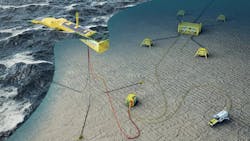Technology breakthroughs driving decarbonization
Editor's note: This article first appeared in the 2024 Offshore Business Strategies Special Report, which published within the May/June 2024 issue of Offshore magazine.
By Rebecca Allison, Net Zero Technology Centre
The push toward achieving net-zero emissions has accelerated innovation, leading to significant developments in technologies to reduce methane emissions, from alternative fuels for power generation, to electrification, to technologies that deliver CCS and hydrogen production.
However, the International Energy Agency estimates that 35% of the emissions reductions needed in 2050 to reach net zero will be delivered by technologies not available on the market today. The Net Zero Technology Centre (NZTC) aims to close the technology gap, co-investing and working with industry, government and academia to drive technology development and deployment as well as deliver advisory solutions to help asset owners and operators decarbonize assets and make the right technology investment decisions.
The challenges of offshore innovation deployment often revolve around the harsh and unpredictable marine environment, high operational costs, testing of technology and scalability. For instance, the installation and maintenance of offshore wind turbines present logistical hurdles due to their remote locations and the complexity of underwater infrastructure. To combat this, floating wind turbines are gaining traction as they can be deployed in deeper waters where wind resources are abundant. Offshore wind energy utilization and power hubs play a key role in electrification options for existing offshore assets. However, there remains a significant challenge in the commercial viability of electrification based on high capex costs and direct impact on the levelized cost of energy.
Harnessing wave energy
Wave energy technology has seen significant progress. NZTC has been supporting the Renewables for Subsea Power project, which connects Mocean Energy’s Blue X wave energy converter with Verlume’s Halo underwater battery storage system.
In February 2024, the project completed a 12-month test program at sea to demonstrate how green technologies can be combined to provide reliable and continuous low carbon power and communications to subsea equipment. This technology offers a cost-effective future alternative to umbilical cables, which are carbon intensive with long lead times to procure and install.
What if electrification isn’t an option?
Electrification isn’t always a feasible option. Carbon capture and storage (CCS) forms a key vector to decarbonizing. While CCS is a proven technology, scaling it is a new challenge. Technology development and innovation will help to overcome barriers such as the high costs involved, the impact of impurities in the CO2 stream, and the monitoring of stored CO2.
NZTC is currently supporting UK-based Pace CCS in the development of their software tool to predict the impact of impurities and corrosion risk to pipelines. The acid and impurities pose a huge corrosion risk, which can lead to CO2 leaks and pipeline failures. Accurate qualification of water and other impurities in multi-component CO2 flow is a critical challenge that needs to be solved for the CCS industry to scale. However, if de-risked, it could result in large cost savings in the buildout of transportation and storage networks.
Partnering for P&A
While some wells can be reused for CCS projects, tens of thousands of offshore wells will need to be decommissioned over the next decade. Through NZTC's Well Decommissioning Collaboration Initiative, it is helping operators reduce the cost of well plug and abandonment (P&A) and reduce emissions. The organization is accelerating the testing, validation and qualification in multi-operator collaboration field trials of solutions that provide alternative barrier materials to cement. NZTC aims to field trial up to five technologies per year, supporting a minimum of three field trials for each, with the goal to have a minimum of six technologies successfully qualified and adopted by 2025.
By addressing challenges, embracing innovation and collaborating across sectors, new innovations can be unlocked and sustainable energy production delivered.
About the Author

Rebecca Allison
Rebecca Allison is COO with Net Zero Technology Centre.
